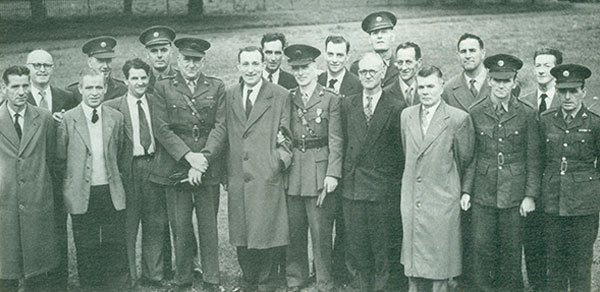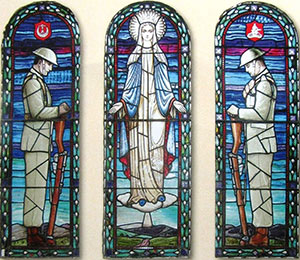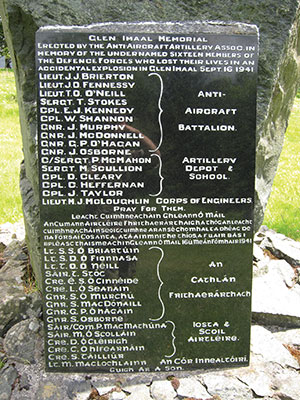The Glen of Imaal disaster, 1941
Published in 20th-century / Contemporary History, Features, Issue 2 (March/April 2019), The Emergency, Volume 27The worst single episode of loss of life suffered by the Irish Defence Forces since the Civil War.
By Terence O’Reilly
By September 1941 the Second World War had been ravaging the continent of Europe for two full years. Ireland had successfully remained neutral, owing in no small part to the rapid expansion of the Defence Forces, which had by now reached a strength of 39,000 men.
On the afternoon of 16September, a party of 60 gunners of the Depot Artillery and the Anti-Aircraft Battalion (and a few members of the Engineer Corps) gathered in the military training area of the Glen of Imaal in the Wicklow Mountains. Among them were several young officers who had been commissioned in the field during a serious invasion scare the previous December.
This group of men were receiving instruction in an anti-tank mine designed by the Army Ordnance Corps in May 1940. Consisting of 25 pounds of gelignite in a waterproofed wooden case, it was designed ‘for demolishing bridges or other works and also for use against tanks and mechanical transport’. Nicknamed ‘butter boxes’, 5,400 of these mines were manufactured during the Emergency, and in practice many received rough treatment without incident, often being bounced about in trucks or even on bicycles.

Explosion
In charge of the exercise was engineer Lt Michael McLoughlin, a graduate of Queen’s University, Belfast, who was considered a particularly experienced explosives instructor. He brought the group along with three mines to an isolated area near Stranahely where the ground was cratered as a result of previous demonstrations. The group then divided, 27 men surrounding McLoughlin and the remainder gathering 50 yards away. McLoughlin knelt to demonstrate the insertion of the detonator, with the others standing or kneeling in a tight group around him; such a practice was apparently common at the time. Some later claimed that the instructor suddenly crouched over the mine in a brave but futile attempt to minimise casualties. Then, with a flash and a roar, the mine exploded with enough force to blast a crater 20ft wide and 7ft deep.
Fifteen men, including four young officers, died instantly, their body parts and personal effects scattered over a wide area. Ten more suffered horrific injuries. Miraculously, two men were unscathed. One of these was Commandant Joseph Kelly, who later recalled:
‘The place was a regular holocaust. There were men dead around me … when I found [Corporal] Cotton he was completely unrecognisable. His face was covered in blood and he was unconscious … he was so bad that I expected him to die.’
Although several men in the second group had suffered minor injuries from flying debris, this party rushed to render assistance. Word was sent to Coolmoney camp and to the Curragh, and soon a stream of lorries and ambulances carried the wounded to the Curragh military hospital, 25 miles away. Around the bloodstained crater local priests administered the Last Rites, while troops and local Gardaí continued to gather up human remains. By nightfall the area had been cleared and the two remaining mines safely detonated. After dark, Donard Garda Station was thronged with soldiers using the telephone to reassure anxious relatives that they were safe.
Twenty wounded men were admitted to the hospital that day, several of whom were rushed to surgery, where twenty medical officers worked through the night. While Corporal William Shannon died during treatment, by the following day all but three of the remainder were out of danger. To Company Sergeant William Bonar and Sergeant William Lennon fell the grim task of identifying the dead in the Curragh mortuary. Lennon sadly recalled: ‘I had trained most of these lads. It was heartbreaking to see them maimed and dead.’ An inquest was soon opened at the Curragh but was adjourned sine die at Garda request.
Funerals

The funerals began on 18September. The previous day a convoy of army lorries carrying the coffins left the Curragh Camp, preceded by an artillery colour party and a military band, with the roads lined with troops. Then the funeral parties went their separate ways. Four lorries carrying nine coffins drove to Arbour Hill church in Dublin, where the requiem Mass was attended by Taoiseach Éamon de Valera, Defence Minister Oscar Traynor and the lord mayor of Dublin. Five Dublin soldiers were buried in Glasnevin cemetery, including Sgt Stokes, whose deceased father was a 1916 veteran. The remains of Lts O’Neill and Brierton were sent by train to their native Cork. Those of Cpl Cleary were driven to Dungarvan, C/Sgt MacMahon to Belmullet and Cpl Heffernan to Kilbeggan. All coffins were covered with the national flag, and with a cap and sword for the officers, and a cap and bandolier in the case of the enlisted men. All funerals concluded with a firing party and a bugler playing The Last Post. The exceptions were Lt McLoughlin and Sgt Scullion. When their cortèges reached the Northern Ireland border, the flags and accoutrements were removed and they continued thereafter as civil funerals.
By this time the three most seriously wounded (Sgt Michael Delaney, Cpl Crowley and Cpl Ned Ward) were ‘progressing satisfactorily’. An eye specialist from Dublin spent the day assessing five soldiers with serious eye injuries. Three (Delaney, Ward and Cpl Seán McNamara) were totally blinded. Cpl Cotton and C/Sgt Pat McNamara had each lost an eye, the latter also suffering deafness. After treatment, all but Cotton were medically discharged the following January, after which they received training at St Bricin’s Military Hospital and from the National Council of the Blind.
Inquest

Early in 1942 questions were asked in the Dáil about these men and also about the pensions granted to the dependants of the dead. The Defence Forces had existed for less than twenty years, during which time few had qualified for military pension. It soon transpired that the relevant legislation had not been updated since 1927, since when seismic economic changes had occurred. The widow and child of Gunner James Osborne, for example, were granted an allowance of sixteen shillings and sixpence per week. On 18 March 1942 the resumed inquest returned a verdict of accidental death, having heard evidence that ‘every precaution had been taken’ and that the explosion was ‘quite accidental’. Modern forensics would have quickly ascertained a cause for the premature explosion, but this was not an option in 1942. The jury recommended that ‘the relatives of the deceased should receive favourable consideration from the authorities’. In early 1943 Oscar Traynor announced impending amendments to the Army Pensions Act to increase allowances paid to the injured and to dependants.
In January 1943, McNamara, Ward and Delaney travelled to England, where they were admitted to St Dunstan’s Industrial Training School in Church Stretton, Shropshire. St Dunstan’s (known today as Blind Veterans UK) was formed in 1915 as a charity to care for the increasing numbers of soldiers blinded on the Western Front. There the trio received rehabilitation, training and lifelong aftercare, all at the expense of St Dunstan’s. The following year McNamara and Ward were employed as civilian switchboard operators in St Bricin’s, while Delaney commenced training as a physiotherapist. Pat McNamara was also employed as a switchboard operator at Kildare Barracks.
Post-traumatic stress disorder
It is safe to say that in the 1940s the psychological effects of trauma were less well understood. A tragic example of this was Cpl Henry Cotton. Although he lost an eye in 1941, he was retained by the Army and in 1945 was even commissioned an officer. By 1947 he was an ordnance lieutenant based in Dublin and a member of Dún Laoghaire Yacht Club. In that year he began suffering mood swings, insomnia and other symptoms of post-traumatic stress disorder, ending a long-term relationship. In January he attempted to enter a house in Dalkey and shot dead two men there, one of whom had been a wartime bomber pilot with the Royal New Zealand Air Force. At Cotton’s subsequent trial it was testified that he was not responsible for his actions and he was found guilty but insane, subsequently serving eight years in a psychiatric institution. More tragedy was to follow. In November 1952 Ned Ward was knocked down by a car in Ranelagh and suffered fatal head injuries.
On 16 September 1958 a striking stained-glass window was unveiled in McKee Barracks garrison church in memory of those who had died seventeen years previously. This featured Our Lady of the Rosary flanked by two Irish soldiers, an engineer and a gunner with rifles reserved, the latter distinguished by his white lanyard and leather bandolier. At their feet was represented the mountains and valleys of the Glen of Imaal. Present at the ceremony were Defence Minister Kevin Boland, the Army’s most senior officers and nineteen survivors of the disaster.
Seán MacNamara passed away in August 1969, having raised a family of six children. Michael Delaney died in April 1973 in Liverpool, where he had spent most of his life. In 1975 An Cosantóir noted that ‘former C/Sgt Pat MacNamara [who had raised nine children] … is still operating the telephone switch in Kildare Barracks and is still as bright as a button’.
By now proposals were being made for a more substantial memorial to be erected in the Glen of Imaal, to consist of a central granite marker surrounded by sixteen smaller rocks. On Sunday 14 September 1986, this became a reality when a fourteen-ton basalt monolith, donated by Cement Roadstone Ltd, with a polished granite plaque bearing the names of the sixteen dead, was unveiled by Environment Minister John Boland near Seskin Bridge (2km from the actual explosion site). Among the 30 attendees were senior army officers and the four remaining survivors: recently retired Pat McNamara, Richie Lennon (who identified the dead), Dan Byrne and Eddie Douglas. The following year sixteen local rick stones were placed around the monolith.
Pat McNamara died in 1991. John Caffrey, the final known survivor, passed away in Drogheda in October 2011, although it is possible that he was outlived by Henry Cotton, who had emigrated to New Zealand. These were the last links to the Glen of Imaal disaster, which remains to this day the worst single episode of loss of life suffered by the Defence Forces since the Irish Civil War.
Terence O’Reilly is the author of Hitler’s Irishmen (Mercier Press, 2008).
















